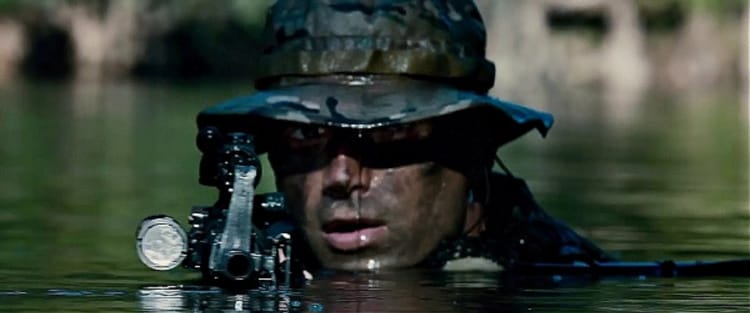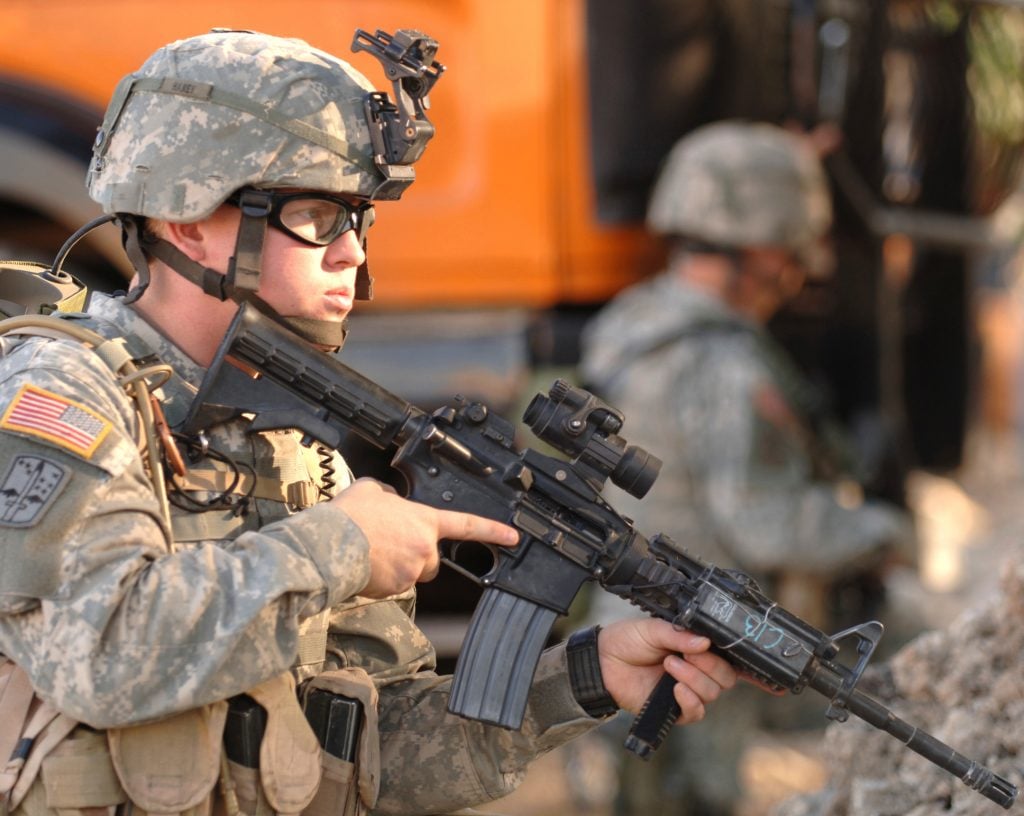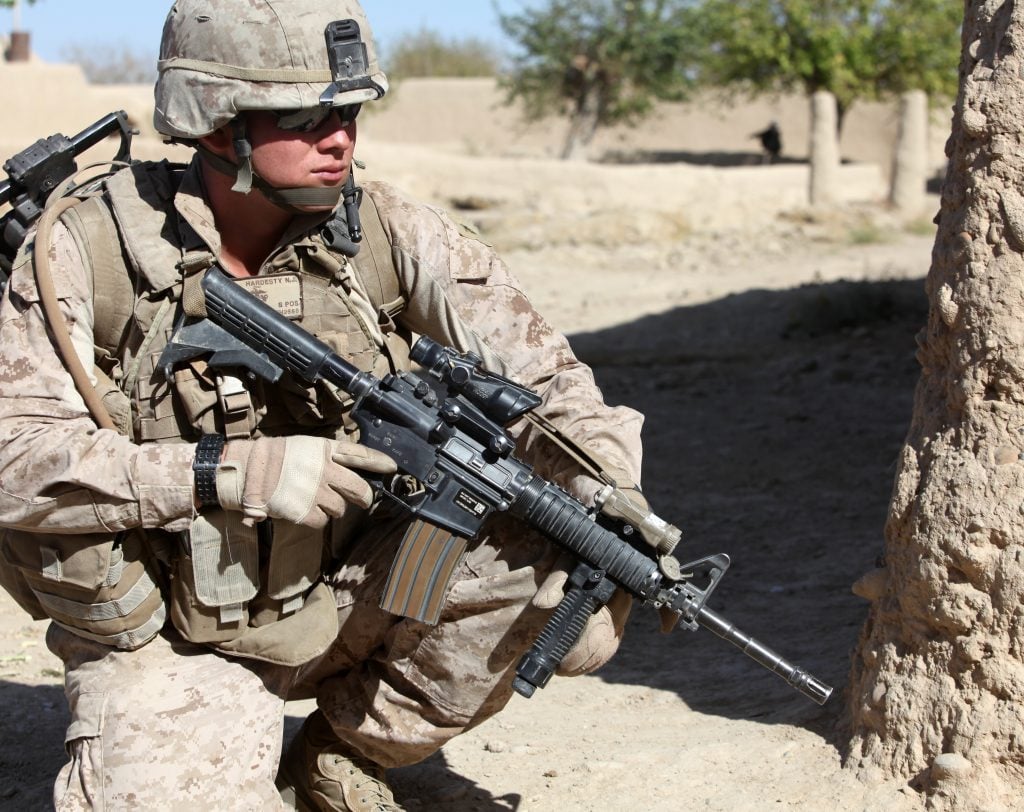The Global War on Terror, aka the GWOT, completely changed the United States military. Any two-decade-long war will do that. We often see periods of great advancement during wars, especially in the fields of weaponry. At the beginning of World War 1, there were soldiers still fighting on horseback with spears, and by the end, airplanes, machine guns, and poison gases dominated the field. Amongst numerous improvements in body armor, vehicles, munitions, and small arms, we saw an embrace of optics.
Optics are nothing on military weapons. Sharpshooters used them as far back as the Civil War. In the United States, optics on rifles were typically reserved for sharpshooters, snipers, and special operations. Your average infantryman used iron sights. Across the pond, the Europeans had embraced optics on the grunt’s rifle well before American forces.
When we entered the GWOT, the most common rifle platform was the M16A2 fit with a carry handle and iron sights. The US Army had adopted a red dot in 1997, but it hadn’t trickled down to everyone. Marines proudly rocked those A2 irons up until 2004. By the time we hit 20086, optics were the norm for almost everyone.
Grunts, engineers, arty guys, truck drivers, and more were issued some form of optic. Iron sights were rare, and by 2006 they were only seen with noncombat reservists doing admin jobs in the green zone. This is in no way a complete accounting of the optics used by the United States, but these are the three optics that defined the Global War on Terror.
The Aimpoint M68 CCO
In 1997 a very forward-thinking Army adopted the M68 CCO. CCO stands for close quarter’s optic. The Aimpoint Comp M2 was the initial optic of choice for the United States Army. Aimpoint didn’t invent the red dot, but they defined the modern red dot. The Comp M2 provided soldiers with a simplified sighting system for their M16 and M4 rifles.

It’s as simple as an optic can get. Soldiers simply put the dot on a properly zeroed Aimpoint and pulled the trigger. Of course, this is an oversimplification. The Army used a 50/200 zero, which basically meant put the dot on it, and it goes down. Up close, there are variations for height over bore, and beyond 200 yards, you had to begin accounting for drop. Regardless it was faster at any range than iron sights.
This was a major improvement on iron sights. It simplified the sighting solution and could be used in any light condition. The Aimpoint optic was extremely durable and very capable. It could survive the abuse that Joe would toss at it. Additionally, the optic worked with night vision for easy aiming without the need for an IR Laser. In 2009 the Army began using Comp M4s as the M68 CCO.

While the optic changed, the designation did not. Soldiers loved the M68 CCO, and the Army’s Combat Survey’s revealed that 85% of soldiers valued the optic. It’s still in use to this day, but the NGSW and optic might put it out of business with combat arms units.
The Trijicon ACOG
SOCOM adopted the ACOG in 1995, and while the Army liked the simplicity of the M68 CCO, they also issued the Trijicon ACOG in limited numbers. Early designated marksmen rifles were nothing more than M4s or M16s with ACOGs. It wasn’t uncommon for a couple of ACOGs to pop up in an Army infantry squad. The Marine Corps adopted the Trijicon ACOG in 2005 in mass.

The Marine Corps has always heavily relied on individual marksmanship skills. “Every Marine Is a Rifleman” is more than a motto. The ACOG provides Marines with a four-powered prism sight. The magnification allowed Marines to see further and shoot further with greater accuracy than a red dot. Additionally, the ACOGs featured a bullet drop compensator that was paired to the Marine Corps rifles and ammo that allowed on the fly elevation adjustments for accurate long-range shooting.
ACOGs are also superbly tough optics. A Marine in Iraq credits his ACOG with saving his life after it took a round from an AKM and prevented that round from hitting him. They were Marine-proof, and Marines can break anything. The ACOG also didn’t need batteries for its illuminated reticle. A combination of fiber optics and tritium gathers external light to power the reticle.

Marines with ACOGs were so effective the Marine Corps launched an investigation. The Marine Corps feared that Marines were executing Iraqis due to the number of headshots reported. The Marines were cleared, and it just turned out that a Marine, an M16, and an ACOG are headshot-making machines in urban warfare.
The EOTech 553 and XPS3
Special operations forces typically get a different set of toys than the regular infantryman. This includes optics, and we’ve seen a variety of optics in the hands of SEALs, Green Berets, Recon Marines, and more. One that seems to continually pop up amongst special operations personnel is the EOTech series of reflex sights.

The EOTech series of optics are not traditional red dot sights. While they function in a similar manner, these are holographic sights. The difference being the reticle is not reflected onto the lens but recorded in three-dimensional space onto a piece of holographic film. This creates a very clear and versatile reticle that is bigger and easier to see and works as a range finder and for leading on moving targets.
The first EOTech adopted was actually marked, Bushnell. EOTech partnered with Bushnell to bring the optic to market, and this model was adopted in small numbers. The first large-scale adoption was of the EOTech 553 sight in 2004. Years later, the EXPS3 replaced the 553 and still serves as the go-to EOTech with Special Operations communities. It’s not uncommon to see these optics paired with magnifiers.
A Post GWOT World
These optics paved the way for the world we have now. The NGSW rifle and optic is essentially a complete aiming system. The Marine Corps adopted a Trijicon 1-8X LPVO, and the latest pistol, the M17, is optics-ready as well. These days optics are making their way to machine guns, handguns, grenade launchers, and more. The genie is out of the box and is certainly not going back anytime soon.

